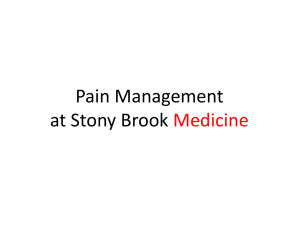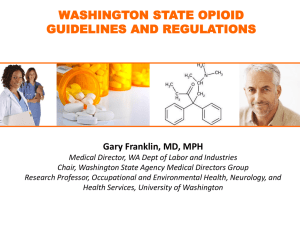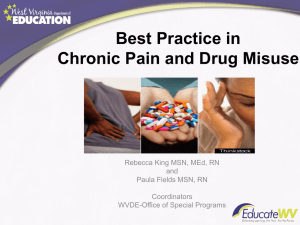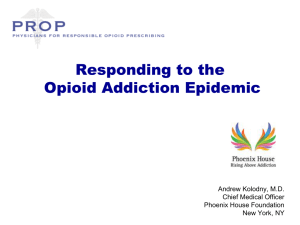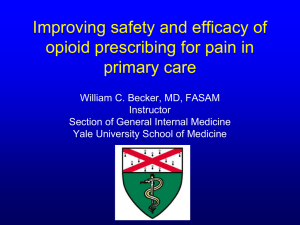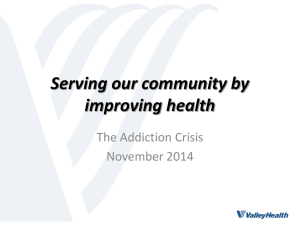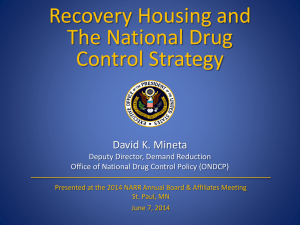Buprenorphine Overview - The American Osteopathic Academy of
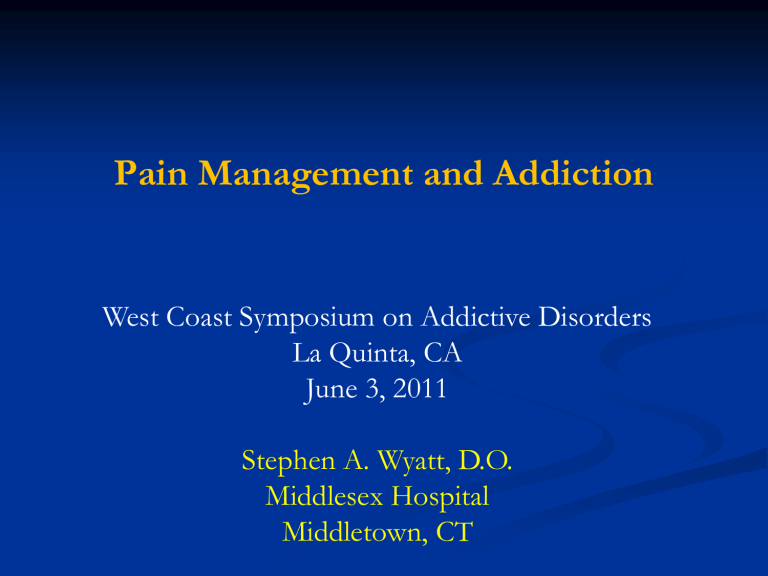
Pain Management and Addiction
West Coast Symposium on Addictive Disorders
La Quinta, CA
June 3, 2011
Stephen A. Wyatt, D.O.
Middlesex Hospital
Middletown, CT
Outline
Introduction
The Opiate Problem
• Identifying the problem with opiates
• How did it occur?
• Pain management vs. Opiate Control
Different types of pain
• Nociceptive and Neuropathic Pain
• Chronic Non-Cancer Pain
Opiates
• Definition
• The danger of long acting opiates
• Potential for addiction
Identification and
Monitoring of Pain &
Addiction
• Assessment
• Monitoring
• Red and Yellow flags
A way out
Case Presentation - PL
•
•
•
57 M,C,♂
Alcohol related injure at
25 resulting in a hip replacement.
Injury to his back at 32 resulting in disability.
Onset of prescribed opiates
•
•
•
•
Remained on disability
Hospitalized 11-08 d/t to Klonopin od
Vicodin (acetaminophen
500mg, Hydrocodone
5mg) #7 / 6 times a day.
Suggested long acting opioid
Case Presentation - PL
• Came for consultation 3/09 Oxycontin 60mg #5
4 time a day
Prevalence of Recurrent and Persistent Pain in the US
• 1 in 4 Americans suffer from recurrent pain (day-long bout of pain/month)
• 1 in 10 Americans report having persistent pain of at least one year’s duration
• 1 in 5 individuals over the age of 65 report pain persisting for more than 24 hours in the preceding month
– 6 in 10 report pain persisting > 1 year
• 2 out of 3 US armed forces veterans report having persistent pain attributable to military service
– 1 in 10 take prescription medicine to manage pain
American Pain Foundation. http://www.painfoundation.org. Accessed March 2010.
The Problem of Pain
Costs US economy estimated
$100 billion/year
Healthcare
Welfare & disability
payments
Lost tax revenue
Lost productivity (work absence)
40 million physician visits annually
Most common reason for medical appointments
Push toward opioid maintenance therapy in non malignant pain
National Institutes of Health. New Directions in Pain Research. Sept 1998. PA-98-
102.
Pain Standards
•
•
•
•
JCAHO – Installs a Quality Standard on pain identification. (2001)
Strong encouragement to increase the identification and treatment of pain.
The development of new and very effective opiates for the treatment of pain.
The tremendous rise in the prescription of opiates for non-cancer pain.
Trend data: Distribution of prescription opioids, U.S., 2000–2007
Source: DEA, ARCOS system, 2007
* Includes OTPs
4
3
2
1
0
8
7
6
5
Deaths per 100,000 related to unintentional overdose and annual sales of prescription opioids by year, 1990 - 2006
Source: Paulozzi, CDC, Congressional testimony, 2007
600
500
400
300
200
100
0
Deaths per 100,000
Opioid sales (mg per person)
8000
7000
6000
5000
4000
3000
Unintentional drug overdose deaths are rising faster for prescription opioids than for illicit drugs
Source: CDC, National Vital Statistics System, 2006
Prescription opioid
Cocaine
Heroin
2000
1000
0
'99 '00 '01 '02 '03 '04
Year
New Illicit Drug Use United States, 2006
2,500
2,150
2,000
2,063
1,500
1,112
1,000
977
860 845
783
500
267
264
0
Pain
Relievers *
Marijuana Cocaine
Tranquilizers Ecstasy
Stimulants
Inhalants
Sedatives
LSD †
91
Heroin
69
PCP †
*533,000 new nonmedical users of oxycodone aged ≥ 12 years. Past year initiates for specific illicit drugs among people aged ≥ 12 years.
† LSD, lysergic acid diethylamide; PCP, phencyclidine.
Substance Abuse and Mental Health Services Administration, Office of Applied Studies. 2006 National Survey on Drug
Use and Health. Department of Health and Human Services Publication No. SMA 07-4293; 2007.
Who Misuses/Abuses Opioids and Why?
Nonmedical
Use
• Recreational abusers
• Patients with disease of addiction
Medical Use
• Pain patients seeking more pain relief
• Pain patients escaping emotional pain
Addiction
Abuse/Dependence
2-5%
Prescription Drug Misuse
20%
Aberrant Medication Use Behaviors:
A spectrum of patient behaviors that may reflect misuse
40%
Total Chronic Pain Population
Adapted from Passik. APS Resident Course, 2007
Where Pain Relievers Were Obtained
Most Recent Nonmedical Use among Past Year
Users Aged 12 or Older: 2006
Source Where Respondent Obtained
Drug Dealer/
Stranger
More than
One Doctor
3.9%
1.6%
Bought on
Internet
0.1%
One Doctor
19.1%
Bought/Took from Friend/Relative
14.8%
Other 1
4.9%
Source Where Friend/Relative Obtained
Free from
Friend/Relative
55.7%
One
Doctor
80.7%
More than One Doctor
3.3%
Free from
Friend/Relative
7.3%
Bought/Took from
Friend/Relative
4.9%
Other 1
Drug Dealer/
Stranger
1.6%
2.2%
Note: Totals may not sum to 100% because of rounding or because suppressed estimates are not shown.
1 The Other category includes the sources: “Wrote Fake Prescription,” “Stole from Doctor’s
Office/Clinic/Hospital/Pharmacy,” and “Some Other Way.”
“Doctors are easy to find and they don’t carry guns”
Medical Economics
“To stop Rx diversion, the agency (DEA) has hired hundreds of new investigators and expanded it’s local and state task forces”
“Quantity alone…may indicated diversion and trigger an investigation”
History
In 1872, California passed the first anti-opium law.
The administration of laudunum, an opium preparation, or any other narcotic constituted a felony.
In 1881, the California was it a misdemeanor to maintain a place where opium was made available.
Private use was not covered by the legislation.
Same year, California became the first state to establish a separate bureau to enforce narcotic laws, and one of the first states to treat addicts.
Connecticut, in 1874, established the narcotic addict was incompetent to attend to his personal affairs.
The law required that he be committed to a state insane asylum for
"medical care and treatment.“
Nevada, in1877, first to make it illegal to sell or dispense opium without a physician's prescription.
Oregon, in 1887, first to pass a comprehensive anti-substance abuse law.
History
The federal Harrison Narcotic Act was passed in 1914.
Official title of the Harrison bill had been "An Act to provide for the registration of, with collectors of internal revenuer and to impose a special tax upon all persons who produce, import, manufacture, compound, deal in, dispense, sell, distribute, or give away opium or coca Leaves,* their salts, derivatives or preparations, and for other purposes."
After passage of the law, this clause ["in the course of his professional practice only"] was interpreted by law-enforcement officers to mean that a doctor could not prescribe opiates to an addict to maintain his addiction.
History
Genesis in two statutes of the early 1970s
Implemented by regulations from HEW in
1975
Revised by HHS in 1987 (42 CFR Part 2)
Congress reaffirmed and reorganized the two statutes into a single act
Federation of State Medical Boards of the United States, Inc
Model Policy for the Use of Controlled Substances for the
Treatment of Pain
Federation of State Medical Boards House of Delegates, May 2004. http://fsmb.org. Accessed March 2010.
FSMB Model Policy
Basic Tenets
• Pain management is important and integral to the practice of medicine
• Use of opioids may be necessary for pain relief
• Use of opioids for other than a legitimate medical purpose poses a threat to the individual and society
• Physicians have a responsibility to minimize the potential for abuse and diversion
• Physicians may deviate from the recommended treatment steps based on good cause
• Not meant to constrain or dictate medical decision-making
FSMB, Federation of State Medical Boards
Pain
The challenge is that
“treating pain is neither an absolute science nor risk-free”
Scott M. Fishman, MD - Anesthesia & Analgesia. 2007;105:8-9
Pain
•
•
•
•
Acute Pain
•
Trauma, injury, dental procedures, and labor and delivery
Chronic Malignant Pain
•
Cancer
Chronic Nonmalignant Pain
•
Arthritis, Disc Disease
Withdrawal-related Pain
A. Nociceptive
Multiple Types of Pain
Noxious
Peripheral
Stimuli
Examples
• Strains and sprains
• Bone fractures
• Postoperative
B. Inflammatory
Inflammation
• Osteoarthritis
• Rheumatoid arthritis
• Tendonitis
C. Neuropathic
Multiple Mechanisms Peripheral Nerve
Damage
• Diabetic peripheral neuropathy
• Post-herpetic neuralgia
• HIV-related polyneuropathy
D. Noninflammatory/
Nonneuropathic
Abnormal Central Processing
No Known Tissue or
Nerve Damage
• Fibromyalgia
• Irritable bowel syndrome
• Patients may experience multiple pain states simultaneously 1
Adapted from Woolf CJ. Ann Intern Med. 2004;140:441-451.
1. Chong MS, Bajwa ZH. J Pain Symptom Manage. 2003;25:S4-S11.
Pain
•
Perception of pain as a 4-step model
•
•
Transduction : Acute stimulation in the form of noxious thermal, mechanical, or chemical stimuli is detected by nociceptive neurons.
Transmission : Nerve impulses transferred via axons of afferent neurons from the periphery to the spinal cord, to the medial and ventrobasal thalamus, to the cerebral cortex
•
•
Perception : Cortical and limbic structures in the brain are involved in the awareness and interpretation of pain.
Modulation : Pain can be inhibited or facilitated by mechanisms affecting ascending as well as descending pathways.
The Pain Pathway
Transmission –
Ascending spinal interpretation
Transduction –
Peripheral Sensory nociceptive
Peripheral nerve stimulation in Pain
•
Nociceptors quality of pain perceived dependent on:
• site of stimulation,
•
• nature of the fibres transmitting the sensation.
• sharp immediate pain ("first pain") transmitted by A delta fibres,
• prolonged unpleasant burning pain mediated through the smaller unmyelinated C fibres.
Modulation receptors on their surfaces effect sensitivity to stimulation.
•
GABA,
•
•
•
•
• opiate, bradykinin, histamine,
Serotonin capsaicin receptors
Mediation of transmission of Pain
• Neurotransmitters mediate transmission of pain in both brain and spinal cord.
• Excitatory neurotransmitters:
• Glutamate and tachykinins, act at the various neurokinin receptors including as substance P ('P is for pain'), neurokinin A and neurokinin B, and on other substances that transmit pain impulses from incoming nerves in the dorsal horn.
• Inhibitory neurotransmitters:
• gamma amino butyric acid (GABA) most prominent.
The Pain Pathway
Perception
Cerebral Cortex
Modulation
Midbrain
- Thalamus,
- Limbic system
Modulation of Pain
• Descending Pain Regulation:
• norepinephrine - alpha-2 stimulatory effects
• serotonin
• opiates relieve pain by stimulating mu and delta receptors at a host of sites.
Perceived Pain - Suffering
•
At risk patients
•
•
•
•
•
•
Past history of substance use disorder
Emotionally traumatized
Dysfunctional / alcoholic family
Lacks effective coping skills
Dependent traits
Stimulus augmenters-deficit in hedonic tone
Paul Farnum, MD PHP, BC
Vicious Cycle of Uncontrolled Pain
Pain
Avoidance
Behaviors
Decreased
Mobility
Social
Limitations Diminished
Self-
Efficacy
Altered
Functional
Status
Chronic
Pain
Does
Not
Necessarily
Equal
Suffering
Ed Salsizt
Multimodal Treatment
Pharmacotherapy
Opioids, nonopioids, adjuvant analgesics
Physical Medicine and Rehabilitation
Assistive devices, electrotherapy
Complementary and Alternative
Medicine
Massage, supplements
Strategies for Pain and Associated
Disability
Lifestyle
Change
Exercise, weight loss
Interventional
Approaches
Injections, neurostimulation
Psychological
Support
Psychotherapy, group support
Fine PG, et al. J Support Oncol. 2004;2(suppl 4):5-22.
Portenoy RK, et al. In: Lowinson JH, et al, eds. Substance Abuse: A Comprehensive Textbook. 4th ed. Philadelphia, PA: Lippincott,
Williams & Wilkins; 2005:863-903.
Considerations
•
•
•
•
•
•
•
What is conventional practice for this type of pain or pain patient?
Is there an alternative therapy that is likely to have an equivalent or better therapeutic index for pain control, functional restoration, and improvement in quality of life?
Does the patient have medical problems that may increase the risk of opioid-related adverse effects?
Is the patient likely to manage the opioid therapy responsibly?
Who can I treat without help?
Who would I be able to treat with the assistance of a specialist?
Who should I not treat, but rather refer, if opioid therapy is a consideration?
Fine PG, Portenoy RK. Clinical Guide to Opioid Analgesia. Vendome Group, New York, 2007.
Non Pharmacologic Interventions
Behavioral Interventions-ie guided imagery, biofeedback
Meditation
Osteopathic Manipulation, Chiropractic, Body work
Acupuncture with or without stimulation
Physical Therapy modalities
Tran-cutaneous Nerve Stimulation
Hypnosis
Non-Opiate Approaches
•
•
•
•
Transduction : nonsteroidal anti-inflammatory drugs
(NSAIDs) and cyclooxygenase (COX)-2 inhibitors -- target the inflammatory processes
Transmission : Local anesthetics, gamma-aminobutyric acid
(GABA) agonists, non-N-methylD-asparate (NMDA) antagonists, COX inhibitors, corticosteroids.
Perception : Influenced by the situation as well as by the individual's experience and culture
Modulation . Antidepressants are useful in treating chronic pain because they increase the availability of serotonin or norepinephrine. in pain-modulating descending pathways.
Recent studies identified tapentadol, bicifadine, as effective.
There is more to treating pain than Opiates….
but opiates remain important!
Opiates
Opiates & Opioids
Opiates = naturally present in opium
e.g. thebaine, codeine, morphine
Opioids = manufactured
Semisynthetics are derived from an opiate
heroin from morphine buprenorphine from thebaine
Synthetics are completely man-made to work like opiates
methadone
Function at Receptors:
Full Agonists
Mu receptor
Full agonist binding …
activates the mu receptor
is highly reinforcing
is the most abused opioid type
includes heroin, methadone, & others
Formulation Points to Consider
•
•
•
•
•
•
•
Dose-limiting issues and toxicity with co-analgesics
•
4 g/day acetaminophen limit
Importance of titration
•
Risk of overdose, challenges of dose conversion during rotation
Pharmacokinetics versus temporal patterns of pain
Adherence
Cost
Convenience
Caregiving issues
Medical issues in opioid prescribing
•
Potential benefits
•
•
•
Analgesia
Function
Quality of life
•
Potential risks
•
•
•
•
•
Toxicity
Functional impairment
Physical dependence
Addiction
Hyperalgesia
Are opioids effective for CNMP?
•
•
What do we know?
What don’t we know?
•
•
•
•
What don’t we know about:
Addiction
Chronic pain
Effects of long term opioid analgesia
Review of opioid efficacy
•
In short-term studies:
•
Single IV study
•
•
Oral studies ≤ 32 wks
Both demonstrate that CNMP can be opioid responsive
46
Review of opioid efficacy (cont.)
•
•
In long-term studies:
•
•
•
Usually observational – non randomized / poorly controlled
Treatment durations ≤ 6 years.
Patients usually attain satisfactory analgesia with moderate non-escalating doses (≤ 195 mg morphine/d), often accompanied by an improvement in function, with minimal risk of addiction.
The question of whether benefits can be maintained over years rather than months remains unanswered.
Ballantyne JC: Southern Med J 2006; 99(11):1245-1255
47
Back Pain
•
•
There has been 423% increase in the expenditure for spine-related narcotic analgesics from 1997 to 2004*
Yet in assessment of health status there has been no significant improvement.
* JAMA February 13,2008 Vol. 299, No. 6
Opioid Hyperalgesia
•
Cellular responses to chronic opioid intake:
•
• an increase in neuropeptides such as dynorphin 11 , cholecystokinin, 12 and substance P 13
• all of which have been demonstrated to enhance pain sensitivity the activation of glial cells, producing inflammatory cytokines and resulting in amplified pain.
14
11. Vanderah TW, Suenaga NM, Ossipov MH, Malan TP Jr. Lai J. Porreca F. J Neuwsci. 2001 ;21:279-
286.
12. Xie JY. Herman DS, Stiller CO. el al. JNeurosci. 2005;25:409-416.
13. King T, Gardel) LR. Wang R. et al. Pain. 2005;! 16:276-288.
14. Watkins LR. Hutchinson MR, Ledeboer A. Wieseler-Frank J, Milligan
ED, Maier SF. Brain Behav linrmin. 2007;2];J31-146.
Opioid Hyperalgesia
•
•
Methadone maintenance patients have a reduction in their pain tolerance.
1
Ballantyne NEJM report 2003, review of opioid therapy for chronic pain- “neither safe nor effective” 2
1. Doverty M, White JM. Somogyi AA, Bochner F. Ali R. Ling W. Pain. 2001:90:91-
96.
2. Ballantyne JC. Mao J. N Engl J Med. 2003:349:1943-1953.
•
•
Conclusions as to opioid efficacy
Opioids are an essential treatment for some patients with CNMP.
•
They are rarely sufficient
•
•
•
They almost never provide total lasting relief
They ultimately fail for many
They pose some hazards to patients and society
It is not possible to accurately predict who will be helped – but those with contraindications are at high risk
Use of Opiates in Pain
Management
•
•
Positioning Opioid Therapy for Chronic Pain
Chronic non-cancer pain: evolving perspective
Consider for all patients with severe chronic pain, but weigh the influences
•
•
What is conventional practice?
Are there reasonable alternatives?
•
•
What is the risk of adverse events?
Is the patient likely to be a responsible drug-taker?
Fine PG, Portenoy RK. Clinical Guide to Opioid Analgesia, 2 nd edition, 2007.
Jovey RD, et al. Pain Res Manag. 2003;8(Suppl A):3A-28A.
Eisenberg E, et al. JAMA. 2005;293:3043-3052.
Gilron I, et al. N Engl J Med. 2005;352:1324-1334.
Treatment goals in managing CNMP:
Improve patient functioning
Identify and eliminate positive reinforcers
Increase physical activity
Avoid opioid misuse and other drug use
The goal is NOT pain eradication!
Chronic Opioid Therapy Guidelines and Treatment
Principles
Patient Selection
Patient Selection and Risk Stratification
(1.1-1.3)
Initial Patient Assessment
Informed Consent and Opioid Management Plans (2.1-
2.2)
High-Risk Patients (6.1-6.2)
Comprehensive Pain Management Plan
Driving and Work Safety (10.1)
Identifying a Medical Home* and When to Obtain
Consultation (11.1-11.2)
Chou R, et al. J Pain. 2009;10:113-130.
*Clinician accepting primary responsibility for a patient’s overall medical care.
Alternatives to Opioid Therapy
Use of Psychotherapeutic
Cointerventions
(9.1)
Chronic Opioid Therapy Guidelines and Treatment
Principles (cont)
Trial of Opioid Therapy
Initiation and Titration of Chronic Opioid
Therapy (3.1-3.2)
Methadone (4.1)
Opioids and Pregnancy (13.1)
Patient Reassessment
Monitoring (5.1-5.3)
Dose Escalations, High-Dose Opioid Therapy, Opioid Rotation,
Indications for Discontinuation of Therapy (7.1-7.4)
Opioid Policies (14.1)
Continue Opioid Therapy
Implement Exit Strategy
Monitoring (5.1-5.3)
Opioid-Related Adverse Effects (8.1)
Breakthrough Pain (12.1)
Chou R, et al. J Pain. 2009;10:113-130.
*Clinician accepting primary responsibility for a patient’s overall medical care.
Initial Visits
•
•
•
•
Initial comprehensive evaluation
•
Risk assessment
•
•
Prescription monitoring assessment
Urine drug test
Opioid treatment agreement
Opioid consent form
Patient education
Principles of Responsible Opioid Prescribing
•
Patient Evaluation
•
•
•
•
•
•
•
•
•
Pain assessment and history
Directed physical exam
Review of diagnostic studies
Analgesic and other medication history
Personal history of illicit drug use or substance abuse
Personal history of psychiatric issues
Family history of substance abuse/psychiatric problems
Assessment of comorbidities
Accurate record keeping
Fine PG, Portenoy RK. Clinical Guide to Opioid Analgesia, 2nd edition, 2007.
DSM-IV Criteria for Opioid Dependence
A maladaptive pattern of substance use, leading to clinically significant impairment or distress, as manifested by three (or more) of the following, occurring at any time in the same 12-month period:
1. Tolerance, as defined by either of the following: a) a need for markedly increased amounts of the substance to achieve intoxication or the desired effect, or b) markedly diminished effect with continued use of the same amount of the substance
2. Withdrawal, as manifested by either of the following: a) the characteristic withdrawal syndrome for the substance, or b) the same (or closely related) substance is taken to relieve or avoid withdrawal symptoms
DSM-IV Criteria for Opioid Dependence
3. The substance is often taken in larger amounts or over a longer period than was intended
4. There is a persistent desire or unsuccessful efforts to cut down or control substance use
5. A great deal of time is spent in activities necessary to obtain the substance, use the substance, or recover from its effects
6. Important social, occupational, or recreational activities are given up or reduced because of substance use
7. The substance use is continued despite knowledge of having a persistent or recurrent physical or psychological problem that is likely to have been caused or exacerbated by the substance
Characteristics of Addiction: The 4 “Cs”
Control (loss of)
Compulsion to use
Consequences (continued use despite negative consequences – family, occupational/educational, legal, psychological, medical )
Craving
Nomenclature in Pain Treatment
Tolerance
Decreased effect over time
Physical Dependence
Withdrawal symptoms upon discontinuation
Addiction
Impaired control, compulsive use, continued use in spite of negative consequences
Pseudo Addiction
Behavior surrounding obtaining adequate pain meds
Pseudo Tolerance
Worsening of underlying condition
Identifying Who Is at Risk for Opioid Abuse and Diversion
•
•
•
•
•
•
•
•
•
Predictive tools
Aberrant behaviors
Urine drug testing
Prescription monitoring programs
Severity and duration of pain
Pharmacist communication
Family and friends
Patients
Risk Assessment Tools
•
•
•
Addiction Severity Index (ASI)
•
Assess current and lifetime substance-use problems and prior treatment
Drug Abuse Screening Test (DAST-10)
•
Screen for probably drug abuse or dependence
Addiction Behaviors Checklist (ABC)
•
Evaluate and monitor behaviors indicative of addiction related to prescription opioids in patients with chronic pain
Passik SD, Squire P. Pain Med. 2009;10 Suppl 2:S101-14.
Risk Assessment Tools (cont)
•
•
•
Screening Instrument for Substance Abuse Potential (SISAP)
•
Identify individuals with possible substance-abuse history
Opioid Risk Tool (ORT)
•
Predict which patients might develop aberrant behavior when prescribed opioids for chronic pain
Diagnosis, Intractability, Risk, Efficacy (DIRE)
•
Predict the analgesic efficacy of, and patient compliance to, long-term opioid treatment in the primary care settin g
Passik SD, Squire P. Pain Med. 2009;10 Suppl 2:S101-14.
Risk Assessment Tools (cont)
•
Screener and Opioid Assessment for Patients with Pain-
Revised (SOAPP-R)
•
Predict aberrant medication-related behaviors in patients with chronic pain considered for long-term opioid therapy
•
•
•
•
Empirically-derived, 24-item self-report questionnaire
Reliable and valid
Less susceptible to overt deception than past version
Scoring: 18 identifies 90% of high-risk patients
Passik SD, Squire P. Pain Med. 2009;10 Suppl 2:S101-14.
Butler SF, et al. J Pain. 2008;9:360-372.
Opioid Risk Tool
5-item initial risk assessment
Stratifies risk into low (6%), moderate (28%) and high (91%)
Family History
Personal History
Age
Preadolescent sexual abuse
Past or current psychological disease www.emergingsolutionsinpain.com
Webster, Webster. Pain Med. 2005
ORT Validation
Mark each box that applies
1.
Family history of substance abuse
– Alcohol
– Illegal drugs
– Prescription drugs
2.
Personal history of substance abuse
– Alcohol
– Illegal drugs
– Prescription drugs
3.
Age (mark box if 16-45 years)
4.
History of preadolescent sexual abuse
5.
Psychological disease
– ADD, OCD, bipolar, schizophrenia
– Depression
Female Male
1
2
4
3
4
5
1
3
2
1
3
3
4
3
4
5
1
0
2
1
• Exhibits high degree of sensitivity and specificity
• 94% of low-risk patients did not display an aberrant behavior
• 91% of high-risk patients did display an aberrant behavior
N = 185
ADD, attention deficit disorder; OCD, obsessive-compulsive disorder.
Webster LR, Webster RM. Pain Med. 2005;6:432-442.
Source: Journal of Pain, The 2009; 10:113-130.e22
(DOI:10.1016/j.jpain.2008.10.008 )
Copyright © 2009 American Pain Society Terms and Conditions
SOAPP
The following survey is given to all patients who are on or being considered for opioids for their pain. Please answer each question as honestly as possible. This information is for our records and will remain confidential.
Your answers will not determine your treatment. Thank you.
Please answer the questions below using the following scale:
0 = Never, 1 = Seldom, 2 = Sometimes, 3 = Often, 4 = Very Often
1. How often do you have mood swings?
О
2. How often do you smoke a cigarette within an hour after you wake up?
0 1 2 3 4
3. How often have you taken medication other than the way that it was prescribed?
О
4. How often have you used illegal drugs (for example, marijuana, cocaine, etc.) in the past five years?
0 1 2 3 4
5. How often in your lifetime have you had legal problems or been arrested?
0 1 2 3 4
Please include any additional information you wish about the above answers. Thank you
Mr. Jackson’s Score =
3
To score the SOAPP, add ratings of all questions.
A score of 4 or higher is considered positive
Sum of
Questions
4
SOAPP
Indication
+
< 4 -
Risk Assessment Tools (cont)
•
•
Pain Medication Questionnaire (PMQ)
•
Assess risk for opioid medication misuse in patients with chronic pain
Current Opioid Misuse Measure (COMM)
•
Periodically monitor aberrant medication-related behaviors in patients with chronic pain currently on opioid therapy
Principles of Responsible Opioid Prescribing
•
•
•
•
•
•
Drug selection, route of administration, dosing/dose titration
Managing adverse effects of opioid therapy
Assessing outcomes
Written agreements in place outlining patient expectations/responsibilities
Consultation as needed
Periodic review of treatment efficacy, side effects, aberrant drug-taking behaviors
Initiation of opioid therapy
•
•
•
•
•
Is there a clear diagnosis ?
Is there documentation of an adequate work-up?
Is there impairment of function ?
Has non-opioid multimodal therapy
Have failed ?
contraindications been ruled out?
Begin opioid therapy:
Document
Monitor
Avoid poly-pharmacy
74
Medical Records
•
Maintain accurate, complete, and current records
•
•
•
•
•
•
•
•
•
Medical Hx & PE
Diagnostic, therapeutic, lab results
Evaluations/consultations
Treatment objectives
Discussion of risks/benefits
Tx and medications
Instructions/agreements
Periodic reviews
Discussions with and about patients
Fishman SM. Pain Med. 2006;7:360-362. Federation of State Medical Boards of the United States, Inc. Model Policy for the
Use of Controlled Substances for the Treatment of Pain. 2004.
Initiation of
Therapy for
Chronic Pain
Marcus DA. Am Fam Physician. 2000;61(5):1331-1338.
Monitoring Chronic
Pain
Review of Efficacy of
Therapy
Marcus DA. Am Fam Physician. 2000;61(5):1331-1338.
Opioid Treatment Agreement
http://www.lni.wa.gov/ClaimsIns/Files/OMD/agreement.pdf. Accessed March 2010.
Opiate management of pain
•
•
A trial (6 mo±) generally is safe
(IF contraindications are ruled out)
Opiate use and decreased activity results in a worsened condition.
•
•
Push functional restoration, exercises
Make increased drugs contingent on increased activity
79
Monitoring:
Regularly assess the 5 A’s:
•
•
•
•
•
Analgesia
Adverse effects
Activity / function
Aberrant behaviors
Affect
Treating the Addicted Patient in
Pain
Pain Treatment in Patients with an Addiction
These patients suffer thrice: from the painful disease from the addiction, which makes pain management difficult from the health care provider’s ignorance
Pain Treatment in Patients with an Addiction
Must consider:
High tolerance to medications
Low pain threshold
High risk for relapse
Pain treatment
Inadequate pain treatment
Psychological status
Pain Treatment in Patients with an Addiction
Search for physical causes
Identify and address possible non-pain sustaining factors
Address and improve functional status
Treat associated symptoms, if indicated
Case management
Pain Treatment in Patients with an Addiction
Address addiction
Use non-pharmacologic approaches, if effective
Use non-opioid analgesics, if effective
Provide effective opioid doses, if needed
Treat associated symptoms, if indicated
Address addiction
Identifying and Managing Abuse and Diversion
•
•
•
•
•
•
Assessing risk and aberrant behaviors
Performing scheduled and random UDTs
Utilization of PMPs
Assessing stress and adequacy of pain control
Developing good communication with pharmacists
Receiving input from family, friends, and other patients
Differential Diagnosis of Aberrant
Drug-Taking Attitudes and Behavior
•
•
•
•
Addiction (out-of-control, compulsive drug use)
Pseudoaddiction (inadequate analgesia)
Other psychiatric diagnosis
•
•
•
•
Organic mental syndrome
(confused, stereotyped drug-taking)
Personality disorder (impulsive, entitled, chemical-coping behavior)
Chemical coping (drug overly central)
Depression/anxiety/situational stressors
(self-medication)
Criminal intent (diversion)
Passik SD, Kirsh KL. Curr Pain Headache Rep. 2004;8:289-294.
Signs of Potential Abuse and Diversion
•
•
•
•
•
•
•
Request appointment toward end-of-office hours
Arrive without appointment
Telephone/arrive after office hours when staff are anxious to leave
Reluctant to have thorough physical exam, diagnostic tests, or referrals
Fail to keep appointments
Unwilling to provide past medical records or names of HCPs
Unusual stories
However, emergencies happen: not every person in a hurry is an abuser/diverter
Drug Enforcement Administration. Don't be Scammed by a Drug Abuser. 1999.
Cole BE. Fam Pract Manage. 2001;8:37-41.
Urine Drug Testing
•
•
•
•
When to test?
•
Randomly, annually, PRN
What type of testing?
•
POC, GS/MS
How to interpret
•
•
Metabolism of opioids
False positive and negative results
What to do about the results
•
Consult, refer, change therapy, discharge
•
Positive and Negative
Urine Toxicology Results
Positive forensic testing
•
•
•
•
•
Legally prescribed medications
Over-the-counter medications
Illicit drugs or unprescribed medications
Substances that produce the same metabolite as that of a prescribed or illegal substance
Errors in laboratory analysis
•
Negative compliance testing
•
•
•
•
Medication bingeing
Diversion
Insufficient test sensitivity
Failure of laboratory to test for desired substances
Heit HA, Gourlay DL. J Pain Symptom Manage. 2004;27:260-267.
Urine Drug Testing
•
Initial testing done with class-specific immunoassay drug panels
•
Typically do not identify individual drugs within a class
• Followed by a technique such as GC/MS
• To identify or confirm the presence or absence of a specific drug and/or its metabolites
Heit HA, Gourlay D. J Pain Sympt Manage. 2004:27:260-267.
Detection of Opioids
•
•
Opiate immunoassays detect morphine and codeine
•
•
Do not detect synthetic opioids
•
Methadone
•
Fentanyl
Do not reliably detect semisynthetic opioids
•
•
Oxycodone
Hydrocodone
•
Hydromorphone
GC/MS will identify these medications
Heit HA, Gourlay D. J Pain Sympt Manage. 2004:27:260-267.
•
UDT Laboratory-Based Tests
GC/MS, LC/
MS, ELISA
•
•
•
•
High sensitivity, high specificity
Expensive
Quantitative
1-3 days for results
RESULTS OF CONTROLLED
SUBSTANCE UDT:
WORKPLACE
Donor Name: Jack
Donor ID #: 1897221
Accession #: None assigned
Date collected: 04/11/2008
Date received: 04/15/2008
Specimen ID #: 1897221-112
Reason for test: Random
Time collected: 1648
Date reported: 04/15/2008
Class or Analyte
AMPHETAMINES
BARBITUATES
BENZODIAZEPINES
CANNABINOIDS
COCAINE
METHADONE
OPIATES
Validity Test
CREATININE
SPECIFIC GRAVITY
Result
NEGATIVE
NEGATIVE
NEGATIVE
NEGATIVE
NEGATIVE
NEGATIVE
POSITIVE
Result
NORMAL at 33.4 mg/dL
NORMAL
Screen Cut-Off
1,000 ng/ml
200 ng/ml
200 ng/ml
50 ng/ml
300 ng/ml
150 ng/ml
100 ng/ml
Normal Range
≥ 20 mg/dL
≥ 1.003
4.6-8.0
MS, mass spectrometry.
Hammett-Stabler CA, Webster LR. A Clinical Guide to Urine Drug Testing. Stamford, CT:
PharmaCom Group Inc; 2008.
Risk Evaluation and Mitigation Strategies
•
•
•
•
•
Position of the FDA
The current strategies for intervening with [the problem of prescription opioid addiction, misuse, abuse, overdose and death] are inadequate
New authorities granted under FDAAA: [FDA] will now be implementing Risk Evaluation and Mitigation Strategies (REMS) for a number of opioid products
[FDA expects] all companies marketing these products to [cooperate] to get this done expeditiously
If not, [FDA] cannot guarantee that these products will remain on the market
Rappaport BA. REMS for Opioid Analgesics: How Did We Get Here? Where are We Going? FDA meeting of manufacturers of ER opioids, FDA White Oak Campus, Silver Spring, MD. March 3, 2009.
NASPER
National All Schedules Prescription Electronic Reporting Act
Signed into law by President
Bush August 2005
Point of care reference to all controlled substances prescribed to a given patient
Each state will implement it’s own program
Treatment tool vs. Law enforcement tool?
Sale of Opioids 1997-2002
450%
400%
350%
300%
250%
200%
150%
100%
50%
0%
73.3%
117.1%
402.9%
410.8%
Morphine Hydrocodone Oxycodone Methadone
Source: 2002 National Survey on Drug Use and Health (NSDUH).
Results from the 2002 National Survey on Drug Use and Health: National
Findings. Department of Health and Human Services
States with Pharmacy Monitoring Programs
Operational PMP:32 Start-up phase: 6 In legislative process: 11 No action: 1
Office of Diversion Control. http://www.deadiversion.usdoj.gov/faq/rx_monitor.htm#1. Accessed March 2010.
•
•
•
Case Study: Opioid Renewal Clinic
What is the impact of a structured opioid renewal program?
Primary goal: reduce oxycodone SA use to 3% of opioids
Setting
•
Primary care
•
•
Managed by nurse practitioner and clinical pharmacist
Philadelphia VA pain clinic
Structured program
•
Electronic referral by PCP
•
•
•
Signed Opioid Treatment Agreement
UDT
Support from multidisciplinary pain team: addiction psychiatrist, rheumatologist, orthopedist, neurologist, and physiatrist
•
Multimodal management
•
•
•
Opioids
NSAIDs and acetaminophen for osteoarthritis
Transcutaneous electrical stimulation (TENS) units
•
•
Antidepressants and anticonvulsants for neuropathic pain
Reconditioning exercises
Wiedemer NL, et al. Pain Med. 2007;8(7):573-584.
Opioid Renewal Clinic: Results
•
•
•
•
•
•
•
OTAs increased: 63 214
Monthly UDTs increased: 80 200
Oxycodone SA use decreased
•
Quarterly costs: $130,000 $5,000
•
Percent of opioids: 22.5% 0.4%
ER visits reduced 73%
Unscheduled PCP visits reduced 60%
PCPs satisfied (questionnaire)
171/335 patients referred had aberrant drug-taking behaviors
•
45% adhered to OTA (resolved aberrant behaviors)
•
•
•
38% self-discharged from ORC
13% referred for addiction treatment
4% consistently negative UDT
Wiedemer NL, et al. Pain Med. 2007;8(7):573-584.
Opioid Abuse-Deterrent
Strategies Hierarchy
Combination Mechanisms
Pharmacologic
• Sequestered antagonist
•
•
•
• Bio-available antagonist
Pro-drug
Capsaicin – burning sensation
Ipecac – emetic
Denatonium
– bitter taste
Physical
•
•
Difficult to crush
Difficult to extract
Deterrent Packaging
•
•
RFID – Protection
Tamper-proof bottles
Prescription Monitoring
Remaining Questions
•
•
•
How much does the barrier approach deter the determined abuser?
How much do agonist/antagonist compounds retain efficacy?
How much do agonist/antagonist compounds pose serious adversity?
WHAT IS ADDICTION?
Physical
Dependence
Does
Not
Necessarily
Equal
Addiction
Ed Salsizt
Pain and Addiction
Chronic
Pain
Does
Not
Necessarily
Equal
Suffering
Ed Salsizt
Pain Treatment in Patients with an Addiction
Avoid the patient’s drug of choice
Consider safer longer acting opioids
Use medication with lower street value
Avoid self administration, if possible
Case management
Pain Treatment in Patients with an Addiction
Explain potential for relapse
Explain the rationale for the medication
Educate the patient and the support system
Encourage family/support system involvement
Frequent follow-ups
Consultations and multidisciplinary approach
Pain Control for Opioid Maintained Patients
Must satisfy baseline opioid requirements before treating pain
The usual maintenance dose (e.g., methadone) will not control the pain
The usual methadone dose needs to be supplemented with appropriate medication(s) for pain control
May need slightly higher amounts for slightly longer periods of time
Monitoring:
Regularly assess the 5 A’s:
•
•
•
•
•
Analgesia
Adverse effects
Activity / function
Aberrant behaviors
Affect
Pain and Affective Disorders
• Commonly reported association of persistent pain with psychological illness.
• Direction of causality is unknown between persistent pain and affective illness.
• Indication are that psychological disorder is a common correlate of persistent pain, and that this association is observed in a wide range of cultural settings.
JAMA. 1998;280:147-151
Ed Salsizt
1.
6.
7.
8.
4.
5.
2.
3.
Differential Diagnoses of
Aberrant Drug Related Behaviors
Addiction
Pseudoaddiction
Other psychiatric disorder
Encephalopathy
Family disturbance
Criminal intent
Exacerbation of pain syndrome
Side effect(s) of opioid
Aberrant Drug Related Behaviors -
Less Predictive of an Addiction
3.
4.
1.
2.
5.
Aggressively complaining of the need for more drug
Drug hoarding during periods of reduced pain
Requesting specific drugs
Openly acquiring similar drugs from other medical sources if primary provider is absent or under-treated
Unsanctioned dose escalation or other non-compliance on one or two occasions
5.
6.
3.
4.
1.
2.
Aberrant Drug Related Behaviors -
Predictive of an Addiction
Selling prescription drugs
Prescription forgery
Stealing or “borrowing” drugs
Obtaining prescription drugs form non-medical sources
Concurrent abuse of alcohol or illicit drugs
Multiple dose escalations or other noncompliance with therapy
Aberrant Drug Related Behaviors -
Predictive of an Addiction
7. Multiple episodes of prescription “loss”
8. Prescriptions from other clinicians/EDs without seeking primary prescriber
9. Deterioration in function that appears to be related to drug use
10. Resistance to change in therapy despite significant side effects from the drug
Differential Diagnosis of Functional Downturn
3.
4.
1.
2.
5.
6.
Syndrome of opioid abuse/dependence
Other substance use disorder
Other psychiatric disorder
Exacerbation of pain syndrome
Other medical problem
Side effect of opioid
A Way Out
Drug Abuse Treatment Act (DATA)
2000 Schedule III substances
ADDICTION:
Obtain DEA waiver; MD/DO
30 patients only for addiction
2007: 30/100 pt limit
Once daily dosing
PAIN:
Any provider with a schedule III DEA can prescribe.
Divided dosing.
Open label study 95 consecutive patients on long term opioid therapy (LTOA) failing treatment based on:
Increased pain
Decreased Functional Capacity
Emergence of opioid addiction (8%)
Induced on buprenorphine 4-16mg (8mg mean dose)
86% Experienced moderate to substantial pain relief
Mood and function improved
8% Discontinued due to side effects or increased pain
Buprenorphine: Pain Dosage
OFF LABEL
Opioid Naïve
1-2 mg BID- QID (3-6mg/day)
Opioid Tolerant
4mg TID-QID (12-16mg/day)
24mg/day upper limits
32mg/day maximum dose
Cost
Suboxone 8mg $5.97 Costco $2.15 FSS
Suboxone 2 mg
Ceiling effect on respiratory depression
14
13
12
11
10
17
16
15
0
PL
Human respiratory rate
1 2 4
Buprenorphine (mg, sl)
8 16 32
Adapted from Walsh et al., 1994
Buprenorphine-Benzodiazepine
Relative Contraindication
CNS depressants and sedatives (eg, benzodiazepines ):
All opioids have additive sedative effects when used in combination with other sedatives
Increased potential for respiratory depression, heavy sedation, coma, and death (France, IV aprazolam and buprenorphine)
Despite favorable safety, use caution with concomitant psychotropics (eg, benzodiazepines)
Disadvantages:
Buprenorphine for Pain
Disadvantages of buprenorphine over pure mu agonists:
Binds so well to mu receptor that other opioids have little effect
No prn short acting opioids for breakthrough pain
Ceiling on effectiveness
24 mg “yellow light
32mg “red light
Personal
Communication
Ed Johnson Phd,
Surgery, Trauma?
FENTANYL?
Buprenorphine:
Dosage Forms
Buprenex: Buprenorphine IM formulation *
Suboxone 8/2 mg, 2/0.5mg **
Buprenorphine/Naloxone sublingual tablet
Subutex 2mg, 8mg**
Buprenorphine sublingual tablet
Transdermal Buprenorphine
Not FDA approved in the US
Implant
Investigational
* Intramuscular form FDA approved for pain
**Sublingual form FDA approved for addiction
Buprenorphine maintained patients
If non-opioids are ineffective, may need to increase or stop buprenorphine and add a pure
Mu agonist for pain (OR-fentanyl)
May need to switch to pure Mu agonist for maintenance (baseline requirements)
Care needed if/when buprenorphine is restarted for maintenance
Case Presentation - PL
Unable to taper at home
Referred to Inpatient Detox for Induction to
Buprenorphine
Significant difficult in getting to moderate withdrawal state
Inducted on 24mg of Buprenorphine
Remains on this dose 2 years later.
Conclusion
• Use of opioids may be necessary for pain relief
• Balanced multimodal care
– Use of opioids as part of complete pain care
– Anticipation and management of side effects
– Judicious use of short and long acting agents
– Focus on persistent and breakthrough pain
– Maintain standard of care
H&P, F/U, PRN referral, functional outcomes, documentation
• Treatment goals
– Improved level of independent function
– Increase in activities of daily living
– Decreased pain
Conclusion (cont)
•
•
Pharmacovigilance
•
•
•
Functional outcomes
Standard medical practice
FSMB policy
Open Issues
•
•
•
•
What is meant by pain management?
Who needs what treatment?
Do universal approaches work?
Does it improve outcomes?
•
•
For patients
For regulators
Some Resources www.AOAAM.org
www.pcss-b.org
www.painedu.com
PainEdu Manual
Opioid Risk Management Supplement www.pain.com
Links to many pain sites www.legalsideofpain.com
Current status of laws regarding opioid Rx www.partnersagainstpain
Purdue site with access to patient management forms

